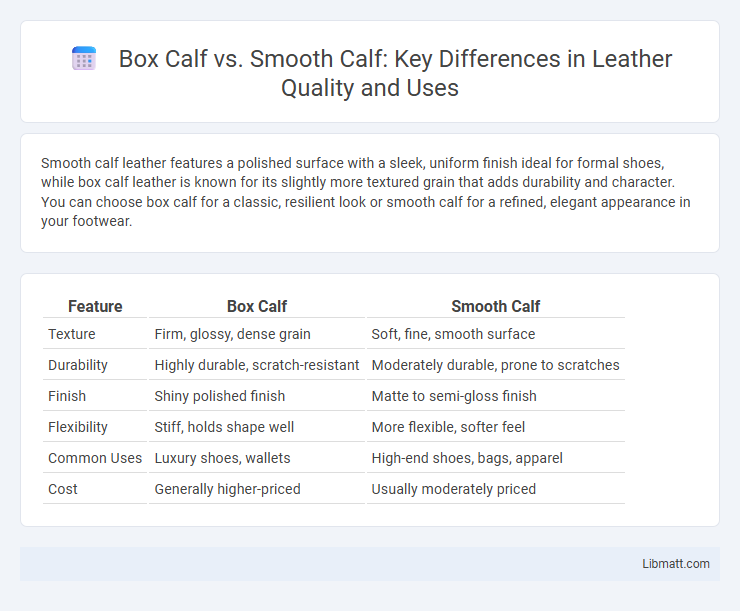Smooth calf leather features a polished surface with a sleek, uniform finish ideal for formal shoes, while box calf leather is known for its slightly more textured grain that adds durability and character. You can choose box calf for a classic, resilient look or smooth calf for a refined, elegant appearance in your footwear.
Table of Comparison
| Feature | Box Calf | Smooth Calf |
|---|---|---|
| Texture | Firm, glossy, dense grain | Soft, fine, smooth surface |
| Durability | Highly durable, scratch-resistant | Moderately durable, prone to scratches |
| Finish | Shiny polished finish | Matte to semi-gloss finish |
| Flexibility | Stiff, holds shape well | More flexible, softer feel |
| Common Uses | Luxury shoes, wallets | High-end shoes, bags, apparel |
| Cost | Generally higher-priced | Usually moderately priced |
Introduction to Calf Leathers
Box calf leather is known for its fine grain, smooth texture, and subtle sheen, making it a preferred material for high-quality dress shoes and luxury accessories. Smooth calf leather, while similar in origin, features a more uniform surface with fewer natural markings, offering durability and a polished appearance suitable for both formal and casual items. Both types are derived from young calves, ensuring softness and flexibility, but box calf is often considered superior in aesthetic refinement due to its meticulous tanning and finishing processes.
What is Box Calf Leather?
Box calf leather is a high-quality, smooth, and tightly grained leather made from the hide of young calves, prized for its durability and polished finish. It undergoes a meticulous tanning process that results in a firm texture with a subtle sheen, making it ideal for luxury shoes and handbags. Your investments in box calf leather products ensure longevity and an elegant appearance resistant to everyday wear.
What is Smooth Calf Leather?
Smooth calf leather is a premium type of calfskin characterized by its fine grain and sleek, uniform surface, offering a polished appearance ideal for high-end leather goods. Unlike box calf, which has a more pronounced texture and natural grain, smooth calf leather provides a softer, more refined finish that enhances its luxurious feel and durability. Its consistent texture makes it a popular choice for luxury handbags, shoes, and wallets, where elegance and subtle sophistication are paramount.
Key Differences: Box Calf vs Smooth Calf
Box calf features a tightly grained, polished surface with a firm texture, ideal for formal shoes, while smooth calf offers a softer, more supple feel with a less pronounced grain, making it versatile for casual and dress footwear. Box calf's durability and glossy finish resist scuffs better, whereas smooth calf ages gracefully, developing a patina that enhances character over time. Your choice depends on the balance between elegance and comfort, with box calf excelling in structured appearance and smooth calf providing flexible wear.
Texture and Appearance Comparison
Box calf leather features a fine, smooth texture with a subtle sheen, giving it a polished and sophisticated appearance ideal for formal footwear. Smooth calf leather also offers a sleek surface but tends to have a slightly softer feel and less uniformity in grain, providing a more casual yet refined look. When choosing between the two, your decision may depend on whether you prefer the precise, glossy finish of box calf or the supple, natural feel of smooth calf.
Durability and Aging Process
Box calf leather is known for its exceptional durability due to its tight grain structure, which makes it resistant to scratches and everyday wear. Smooth calf, while still durable, tends to develop character more quickly through natural creasing and patina, enhancing its aesthetic appeal over time. Your choice depends on whether you prefer a leather that maintains a pristine look or one that evolves with age.
Common Uses in Luxury Goods
Box calf leather is frequently used in luxury goods such as high-end dress shoes and wallets due to its smooth texture and durability, offering a refined appearance ideal for formal accessories. Smooth calf leather, prized for its consistent grain and supple feel, is commonly found in premium handbags, gloves, and watch straps, adding elegance and comfort to your luxury collection. Both types emphasize quality and craftsmanship, with Box calf favoring structure and smooth calf delivering versatility in sophisticated designs.
Care and Maintenance Tips
Box calf leather requires regular conditioning with a high-quality leather balm to maintain its glossy finish and prevent cracking. Smooth calf benefits from gentle cleaning using a damp cloth and mild soap, followed by applying a moisture-rich conditioner to preserve its soft texture. Both types should be stored in a cool, dry place away from direct sunlight and excessive humidity to extend their lifespan.
Pros and Cons of Each Leather Type
Box calf leather offers exceptional durability and a slightly textured finish that resists wear, making it ideal for long-lasting shoes and accessories; its main drawback is that the texture can sometimes appear less polished. Smooth calf leather provides a sleek, glossy appearance prized for formal and luxury items, but it may show scratches and scuffs more readily, requiring careful maintenance. Choosing between the two depends on whether you prioritize ruggedness and texture with box calf or elegance and sheen with smooth calf for your leather goods.
Which Should You Choose: Box Calf or Smooth Calf?
Choosing between box calf and smooth calf leather depends on your preference for durability versus texture. Box calf offers a slightly firmer, embossed grain that enhances scratch resistance and longevity, ideal for formal shoes that require maintaining a polished appearance. Smooth calf, with its softer, finer texture, provides a sleek and supple finish favored for classic elegance but requires more careful maintenance to prevent visible scuffs.
Box calf vs smooth calf Infographic

 libmatt.com
libmatt.com